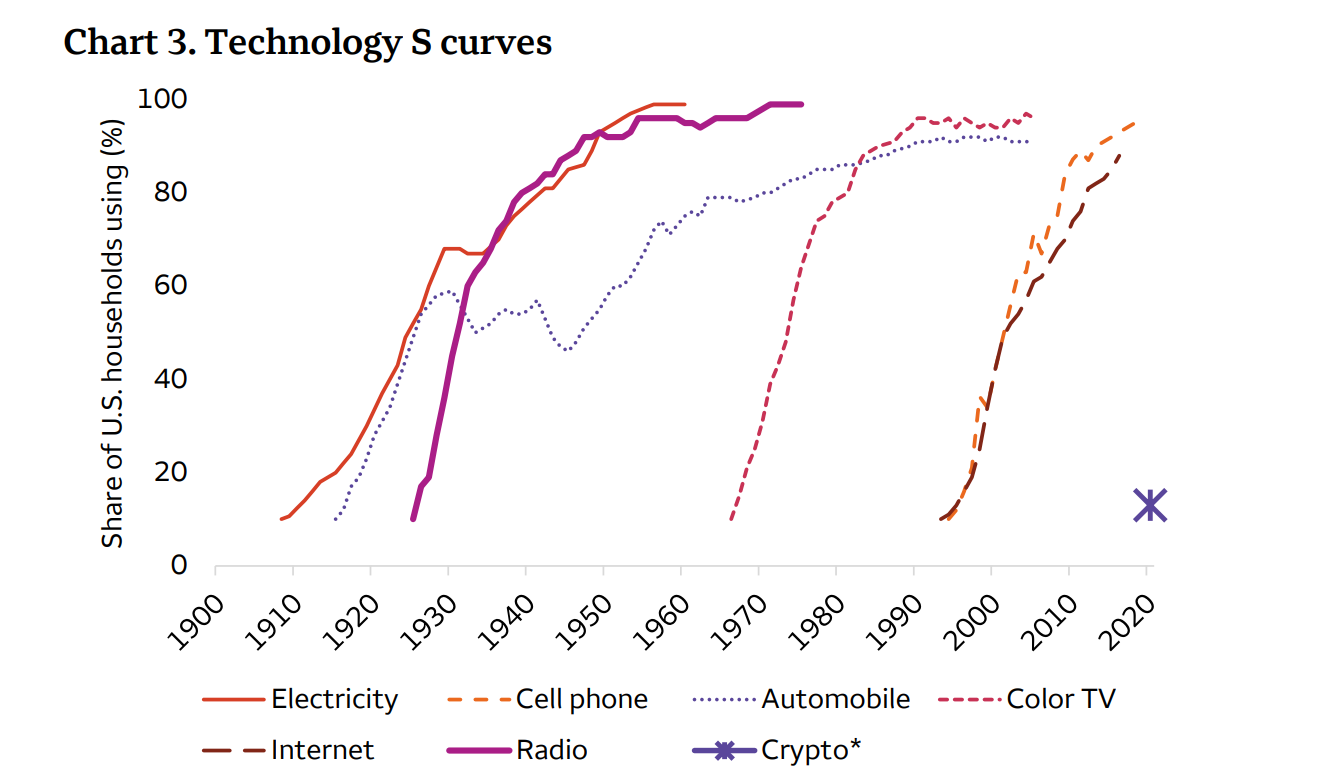09 Feb 2022 Jane Whitmoore
Crypto Is Following The Internet Adoption Curve, A Report Shows
The massive crypto adoption that the sector experienced during the past couple of years seems to be going full steam ahead, especially after KPMG Canada added Bitcoin and Ethereum to its corporate treasury, while both governments and businesses are finding ways to either accept cryptos as legal tender or at least put clear regulations to the emerging sector.
Meanwhile, a report from the Wells Fargo Investment Institute found many similarities between the world of cryptocurrencies and the Internet revolution of the early 1990s. In the paper, Wells Fargo draws a parallel between the common slow initial adoption rates, but as the Internet “hit an inflection point, and then steeply accelerated”, this could mean widespread crypto adoption is yet to come, witnessing a similar spike.
 Source: Wells Fargo
Source: Wells Fargo
Delving further into the report, it turns out that a mere 1% of the world population and 14% of Americans were using the internet by 1995, despite the Internet being born in 1983. In turn, Crypto.com data shows that by 2021 almost 3% of the world’s population had become crypto users (221 million in June 2021). However, the rate of crypto adoption is much faster, as at the start of 2021, the global crypto users were half as many, or around 100 million.
However, Fargo Wells acknowledges the fact that a common factor among how users interact with new technologies, especially in their early stages, is the period of time many need to “figure out what the technology is, what it can do, and how it can benefit them.”
For the case with cryptocurrencies, many new users believe that the $2 trillion crypto sector is still in its early adoption stage, “as they find the technology daunting and use cases unclear,” while new sub-sectors like DeFi, NFTs, and Metaverse are further reaching out to people outside the financial ecosystem.
Data from the report also showcase different technologies and their so-called inflection points, hinting out that the crypto sector might soon reach that point.
“For the internet, that point was the mid-to-late 1990s. After a slow start in the early 1990s, internet use surged from 77 million in 1996 to 412 million in 2000. By 2010, worldwide internet use had grown to 1.98 billion, and today it sits at 4.9 billion”, Wells Fargo noted.
 Source: Wells Fargo
Source: Wells Fargo
The investing advisor emphasized that crypto adoption eventually will follow the same adoption path as other digital inventions, such as wireless technologies, smartphones, remittance services, and social media, which are now embedded in the majority of people’s lives.
Is the crypto sector entering an early majority stage?
The adoption curve of the crypto sectors represents the cumulative rate at which users adopt and react to crypto innovation over time. This curve and its user base can be split into five distinguishable segments, based on Everett Rogers’s diffusion of innovations - Innovators, Early Adopters, Early Majority, Later Majority, and Laggards.
The latest wave of institutional adoption, despite the price turbulence, showcases that the crypto sector is now in its early majority state, as more investors are likely to lose the fear of the crypto industry and join the crypto bandwagon.
However, the ongoing regulatory uncertainty, combined with the increased risks of fraudulent behavior, when compared to products like debit cards or online payments, for example, may hinder the adoption rate. Nevertheless, governments across the globe are already putting the work to either set a clear regulatory framework for the crypto sector or improve its own portfolio of products and services. China, for example, is leading the pack into developing and releasing its own digital currency, with many countries following suit and exploring the needs, opportunities, and risks of issuing a central bank digital currency, or CBDC.
cryptocurrencies cryptocurrency news internet crypto news Adoption





























